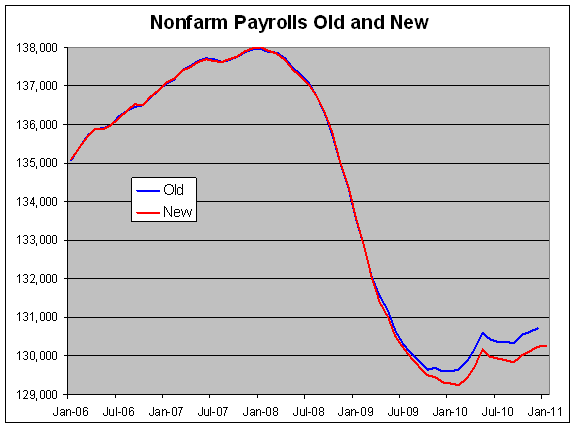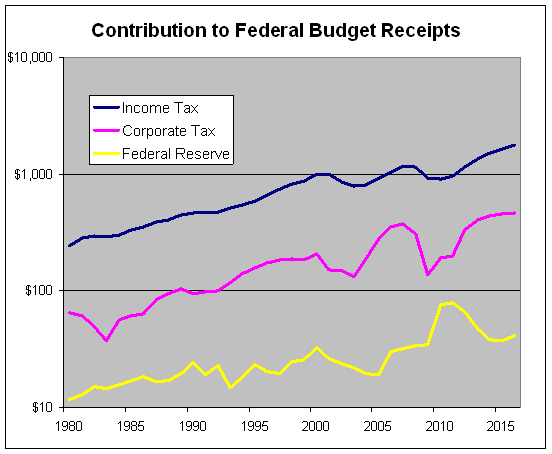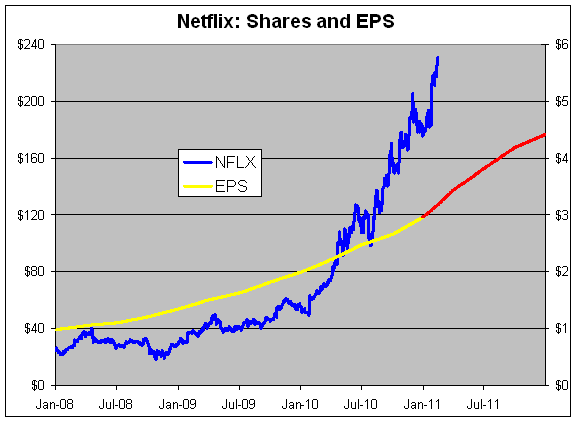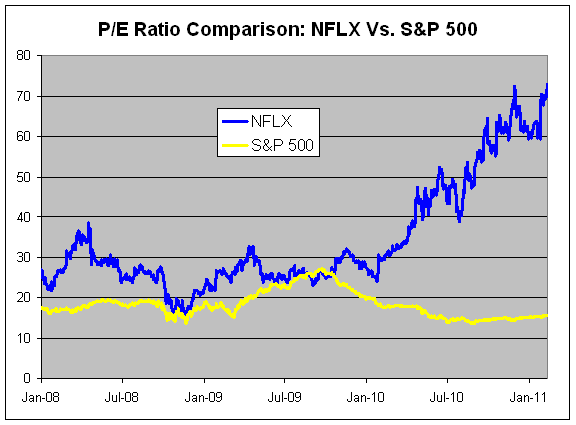Archive for February, 2011
-
Job Losses Were Even Worse Than Thought
Eddy Elfenbein, February 15th, 2011 at 3:11 pmThe government recently conducted its annual update to its benchmark for calculating nonfarm payrolls. As it turns out, the job losses were even worse than we originally were told.
Here’s a comparison of old and new (the jobs figures and in thousands):
From January 2008 to February 2010, the economy lost 8.75 million jobs.
-
Is There a More Frivolous Columnist Than Paul Farrell?
Eddy Elfenbein, February 15th, 2011 at 2:35 pmThis column by Paul Farrell at MarketWatch is truly one of the most idiotic things I’ve read in a long time. Here’s the opener:
Fed boss Ben Bernanke is the most dangerous human on earth, far more dangerous than Hosni Mubarak, Egypt’s 30-year dictator, ever was. Bernanke rules a monetary dictatorship that will trigger the coming third meltdown of the 21st century.
But this reign of economic terror will end.
Just as Mubarak was blind to the economic needs of the masses and democratic reforms, Bernanke is blind to the easy-money legacy that’s set the stage for revolution, turning the rich into super rich while the middle class stagnates and peanuts trickle down to the poor.
Warning, Egypt also had a huge wealth gap before its revolution. Bernanke is the final egomaniac in America’s bubbling 30-year wealth gap, where the top 1% went from owning 9% of America’s wealth to owning 23% during this…
-
JPM’s Investor Day
Eddy Elfenbein, February 15th, 2011 at 8:34 amJPMorgan Chase (JPM) is having its investor day today. TheStreet notes that Wall Street loves the stock. JPM has 28 “buy” ratings and five “holds.”
JPMorgan stands to benefit from every facet of economic growth, ranging from higher consumer spending to a buoyant equity market. However, the recent quarterly performance was bolstered by a net decrease in credit reserves to $33 billion. Although JPMorgan’s investment-banking revenue decreased 21% during the quarter, hurt by higher expenses, the bank ranked No. 1 for global fees. In contrast, the bank’s real estate portfolio produced a quarterly net loss of $823 million, an improvement from the $1.7 billion loss in the year-earlier quarter, but still a sign of weakness. JPMorgan boosted its allowance for loan losses on the Washington Mutual credit-impaired loan portfolio to $2.1 billion. JPMorgan bought WaMu in 2008.
JPMorgan’s diversified approach, particularly its retail and small-business exposure, is proving a superior strategy to the capital-markets exclusivity of Goldman Sachs (GS). Furthermore, loan modifications and amplified lending to small businesses has helped JPMorgan, which, like most too-big-to-fail institutions, accepted funds from the Troubled Asset Relief Program, or TARP, to restore its public image faster than peers. However, a recent suit against the company, alleging it complied in Bernie Madoff’s Ponzi scheme, has taken a PR toll as has admission that the bank wrongly overcharged thousands of military families, with members serving overseas, on their mortgages and improperly foreclosed on more than a dozen.
In the morning news, we pointed out that Marriott (MAR) is planning to split itself into two companies. I like to see when good companies split themselves up. Investors can often find good deals.
Recently, Motorola split itself into Motorola Mobility (MMI) and Motorola Solutions (MSI). I’ve written before that I highly doubt either company will keep Motorola in their names. Also, I think MSI will probably be the stronger performer.
-
Morning News: February 15, 2011
Eddy Elfenbein, February 15th, 2011 at 7:34 amDeutsche Boerse, NYSE Boards to Vote Today on Combining
Asian Markets End Mixed: China Flat Despite Below-View CPI
Inflation Hits Nearly 5 Percent in China, With Food Costs Soaring
Bank of Japan Tones Up Economic Optimism, Keeps Rates on Hold
Train Strike Adds to Debt-laden Portugal’s Woes
Companies Raise Prices as Commodity Costs Jump
Bernanke Would Defend Lehman Actions to His `Deathbed’
FedEx Cuts Forecast, Citing Fuel and Weather
Elop, Ballmer Give Nokia-Microsoft Software Accord Hard Sell
Marriott to Split Into Two Companies
Paul Kedrosky: Google Goes After Content Firms Again
Joshua Brown: Advising Social Media Millionaires
Howard Lindzon: The Rich are Early and Late…Because They Can Afford to Be
-
The Federal Reserve Pays More in Taxes than the Bottom Two-Thirds of American Earners Combined
Eddy Elfenbein, February 14th, 2011 at 10:28 pmHere’s a look at three sources of revenue for the federal government: individual income taxes, corporate income taxes and payments from the Federal Reserve. The chart is in billions of dollars and the numbers come from President Obama’s budget.
What’s fascinating is that the Fed’s payments are getting to be a hefty share of the government’s revenue (although the White House projects it will fall off soon). For 2010 and 2011, the Fed’s share is equal to 8.4% and 8.3% of individual income taxes respectively.
Given the heavily skewed nature of income taxes, the Federal Reserve pays more in taxes than a hefty slice of America.
We don’t yet have the income tax distribution figures for 2010. The latest are from 2008 and they show that the bottom 50% of taxpayers paid 2.7% of all income taxes. The second quartile (25% to 50%) paid 10.96% of all income taxes.
Assuming that same distribution held in 2010 and will hold in 2011, and by using some very rough interpolation, we can estimate that the Federal Reserve will probably pay more in taxes this year and last year than the bottom two-thirds of all Americans combined.
Update: David Merkel helpfully tweets: “The Fed doesn’t pay taxes; they remit excess seigniorage revenue to the Treasury, which they gather through punishment of savers.”
-
Buffett Makes Some Moves
Eddy Elfenbein, February 14th, 2011 at 10:11 pmAccording to the latest filings, Warren Buffett has made some changes to his massive portfolio which included trimming two stocks on our Buy List (FISV and BDX).
Berkshire sold off 5 million shares of Bank of America Corp., 187,000 Comcast Corp. shares, 6.5 million Lowe’s Cos. shares and 3.6 million shares of Nike Inc.
Berkshire also unloaded 1.9 million shares of Becton, Dickinson & Co., 3.9 million shares of Fiserv Inc., 6.1 million shares of Nalco Holding Co. and 3.4 million shares of Nestle.
And Berkshire reduced its stake in Bank of New York Mellon Corp. just three months after it revealed a new investment of nearly 2 million shares in the bank. At year end, Berkshire held 1.79 million shares of BNY Mellon.
Besides investments, Berkshire owns more than 80 different subsidiaries, including clothing, insurance, furniture, utility, jewelry and corporate jet companies.
-
Looking at Netflix’s Valuation
Eddy Elfenbein, February 14th, 2011 at 7:18 pmHere’s a look at Netflix’s stock along with its earnings-per-share. The stock is in blue and it follows the left scale. The earnings are in gold and follow the right scale. Wall Street’s projections are in red.
I’ve scaled the ratios at a ratio of 40-for-1 so whenever the lines cross, the P/E Ratio is exactly 40. That’s much higher than I normally use but the chart would be difficult to read at a ratio less than that. At this earlier post, I used a ratio of 20-for-1 and we’ve run so far past that.
Here’s a comparison of the P/E Ratio of the S&P 500 and that of Netflix. It wasn’t too long ago that they were similar.
-
50-DMA Streaks
Eddy Elfenbein, February 14th, 2011 at 1:20 pmThe S&P 500 is very close to doubling from the March 2009 low. The intra-day low from March 6, 2009 was 666.79. To double that, we need to hit 1,333.58. We’ve been as high as 1,331.64 today.
The S&P 500 continues to hold above its 50-day moving average. We’ve been above it every day since September 2, 2010. This is the 11th longest streak since 1932.
Begin End Days 4-Jan-95 10-Jan-96 257 10-Apr-58 25-Nov-58 159 14-Dec-42 21-Jun-43 156 24-Jul-06 27-Feb-07 149 4-Nov-60 12-Jun-61 148 5-Apr-35 20-Sep-35 140 29-Nov-63 1-Jun-64 126 31-Mar-89 25-Sep-89 123 23-Nov-70 17-May-71 120 25-Jan-83 12-Jul-83 116 2-Sep-10 14-Feb-11 114 -
Federal Reserve’s Profits Projected to Fall
Eddy Elfenbein, February 14th, 2011 at 11:03 amBy law, the profits of the Federal Reserve are limited to 6%. Every dime over that goes right to the U.S. Treasury. Lately that’s been a big fat wad of cash, since — frankly — it’s just about impossible for a central bank to lose money.
Obama’s latest budget projects that the Fed’s payment to the Treasury will decline sharply over the next few years:
Fed deposits will reach a record estimated $79.5 billion in the fiscal year ending Sept. 30 before declining 53 percent through fiscal 2015 to $37.4 billion, according to the budget released today. The central bank’s annual remittances averaged $33.3 billion from fiscal 2007 through 2009.
The central bank’s increased payments reflect income from $2.3 trillion in mortgage and Treasury securities it’s purchasing as part of efforts to revive the economy after the worst financial meltdown in seven decades. Declining payments would reflect higher short-term interest rates in a “much stronger” economy that’s generating more tax revenue, Fed Chairman Ben S. Bernanke said last week.
The administration’s budget estimates Fed deposits of $65.8 billion on fiscal 2012; $47.4 billion in 2013; $38.2 billion in 2014; $37.4 billion in 2015; and $41 billion in 2016.
Less money from the Fed means that everyone would be doing better.
-
Netflix Is Still Way Too Expensive
Eddy Elfenbein, February 14th, 2011 at 9:26 amI regret that I must admit that I have a terrible track record with Netflix (NFLX). Last April, I called Netflix “the absolute worst stock to buy.” Not only was I wrong, but I was horribly wrong. The stock has soared dramatically ever since.
On top of that, I got an email from the CEO telling me I had misspelled the name of the company. (For the record, it’s Netflix, not NetFlix. Consider yourself warned.)
Let me clear up a point of confusion about investing. Stock analysis isn’t about predicting the future; it’s about making reasonable judgments about the future. Everyone is going to be wrong. If I could predict the future accurately, well…I wouldn’t be bothering myself with stocks.
Still, it’s important to learn from your mistakes. The judgments of the market can be very humbling. I’ve looked at the numbers and I still think Netflix is dramatically overpriced. Unfortunately, I don’t have the ability to say that it won’t become evermore overpriced.
Let’s look at some of the math. For 2010, Netflix had a net profit margin of 7.4%. The current market value is $12.2 billion. Assuming the margins stay constant, Netflix will need to generate revenues of $165 billion to earn its market value back. That works out to about $500 per every person in North America.
Now let’s add some context. Last year, Netflix generated revenues of $2.1 billion. This year, they’re projected to generate revenues of $3.1 billion. We’re at the point where people are only buying Netflix because they think they can dump the shares off at a higher price to someone else. This is also known as “the Greater Fool Theory.” The problem isn’t that it doesn’t work. It does work, just for everyone else.

-
-
Archives
- May 2025
- April 2025
- March 2025
- February 2025
- January 2025
- December 2024
- November 2024
- October 2024
- September 2024
- August 2024
- July 2024
- June 2024
- May 2024
- April 2024
- March 2024
- February 2024
- January 2024
- December 2023
- November 2023
- October 2023
- September 2023
- August 2023
- July 2023
- June 2023
- May 2023
- April 2023
- March 2023
- February 2023
- January 2023
- December 2022
- November 2022
- October 2022
- September 2022
- August 2022
- July 2022
- June 2022
- May 2022
- April 2022
- March 2022
- February 2022
- January 2022
- December 2021
- November 2021
- October 2021
- September 2021
- August 2021
- July 2021
- June 2021
- May 2021
- April 2021
- March 2021
- February 2021
- January 2021
- December 2020
- November 2020
- October 2020
- September 2020
- August 2020
- July 2020
- June 2020
- May 2020
- April 2020
- March 2020
- February 2020
- January 2020
- December 2019
- November 2019
- October 2019
- September 2019
- August 2019
- July 2019
- June 2019
- May 2019
- April 2019
- March 2019
- February 2019
- January 2019
- December 2018
- November 2018
- October 2018
- September 2018
- August 2018
- July 2018
- June 2018
- May 2018
- April 2018
- March 2018
- February 2018
- January 2018
- December 2017
- November 2017
- October 2017
- September 2017
- August 2017
- July 2017
- June 2017
- May 2017
- April 2017
- March 2017
- February 2017
- January 2017
- December 2016
- November 2016
- October 2016
- September 2016
- August 2016
- July 2016
- June 2016
- May 2016
- April 2016
- March 2016
- February 2016
- January 2016
- December 2015
- November 2015
- October 2015
- September 2015
- August 2015
- July 2015
- June 2015
- May 2015
- April 2015
- March 2015
- February 2015
- January 2015
- December 2014
- November 2014
- October 2014
- September 2014
- August 2014
- July 2014
- June 2014
- May 2014
- April 2014
- March 2014
- February 2014
- January 2014
- December 2013
- November 2013
- October 2013
- September 2013
- August 2013
- July 2013
- June 2013
- May 2013
- April 2013
- March 2013
- February 2013
- January 2013
- December 2012
- November 2012
- October 2012
- September 2012
- August 2012
- July 2012
- June 2012
- May 2012
- April 2012
- March 2012
- February 2012
- January 2012
- December 2011
- November 2011
- October 2011
- September 2011
- August 2011
- July 2011
- June 2011
- May 2011
- April 2011
- March 2011
- February 2011
- January 2011
- December 2010
- November 2010
- October 2010
- September 2010
- August 2010
- July 2010
- June 2010
- May 2010
- April 2010
- March 2010
- February 2010
- January 2010
- December 2009
- November 2009
- October 2009
- September 2009
- August 2009
- July 2009
- June 2009
- May 2009
- April 2009
- March 2009
- February 2009
- January 2009
- December 2008
- November 2008
- October 2008
- September 2008
- August 2008
- July 2008
- June 2008
- May 2008
- April 2008
- March 2008
- February 2008
- January 2008
- December 2007
- November 2007
- October 2007
- September 2007
- August 2007
- July 2007
- June 2007
- May 2007
- April 2007
- March 2007
- February 2007
- January 2007
- December 2006
- November 2006
- October 2006
- September 2006
- August 2006
- July 2006
- June 2006
- May 2006
- April 2006
- March 2006
- February 2006
- January 2006
- December 2005
- November 2005
- October 2005
- September 2005
- August 2005
- July 2005




 Eddy Elfenbein is a Washington, DC-based speaker, portfolio manager and editor of the blog Crossing Wall Street. His
Eddy Elfenbein is a Washington, DC-based speaker, portfolio manager and editor of the blog Crossing Wall Street. His